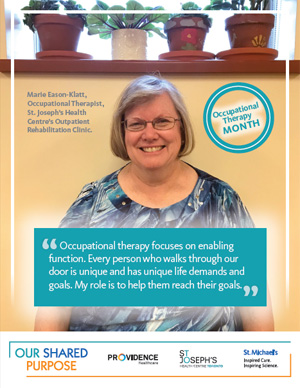All about the holistic work of occupational therapists

It can be helping people to get back to bathing, making meals, or exercising.
October is Occupational Therapy month and we interviewed three occupational therapists across the network who work with very different patient groups to highlight the diversity of their roles and the impact of their work on their patients.
The “occupation” in occupational therapy refers to anything one does to occupy their time.
Occupational therapists work with individuals whose ability to perform some day-to-day activities is impacted by illness or injury. These activities are divided into three general categories:
- Self-care: bathing, eating meals, taking medications
- Productivity: buying groceries, making meals, going to school or work
- Leisure: traveling, reading, exercising, listening to music
 Marie Eason-Klatt: An occupational therapist who specializes in hand therapy at St. Joseph’s Health Centre’s Outpatient Rehabilitation Clinic.
Marie Eason-Klatt: An occupational therapist who specializes in hand therapy at St. Joseph’s Health Centre’s Outpatient Rehabilitation Clinic.
What patient population do you work with?
I see patients of all ages who have sustained injuries to their hands or who have conditions and diseases that impact their ability to use their hands for functional activities. I work with a broad range of age groups from infants with congenital hand abnormalities to elderly patients with fractures in their hands.
However, the majority of patients that I work with are adults of a working age who are referred to me following a trauma to their hands or upper limbs. My practice directly supports the Plastic Surgery and Orthopaedic Surgery services at St. Joseph’s.
What does your role entail?
Following a hand injury, I often need to fabricate a custom orthosis or splint for a patient to allow some hand function during the period of fracture healing. I use both hand exercises and activities throughout their rehabilitation to improve their movement and function. Treatment may consist of grasping light objects to enable feeding using their affected hand or working with dressing boards to assist them with returning to dressing independently.
Since most of the patients I see are of working age, their main goal is to resume their occupational role following a hand injury. We discuss the physical demands of their job and I monitor their range of motion, grip strength and pinch strength throughout their rehabilitation, and I design a treatment program where they practice using various pieces of equipment that they will be using at work. This may include wrenches, screw drivers, keyboards, and computer mice.
As for leisure activities, an example of work I’ve done with my patients is providing an anti-vibration glove for them to be able to return to golfing following a nerve injury.
The scope of occupational therapy is very broad, because the scope of people’s lives is very broad.
Why did you choose occupational therapy as your career?
I chose occupational therapy originally because I knew the profession was diverse enough to hold my interest, and I was right!
My area of work is also very closely and uniquely tied to surgical developments. The majority of my patients come in to see me after they’ve received orthopaedic or plastic surgery on their hands. With advancements in surgery and research, and with development of new thermoplastics I use to fabricate custom orthoses, my practice has really evolved.
Every person who walks through our door is unique and has unique life demands. My role is to help them reach their goals.
